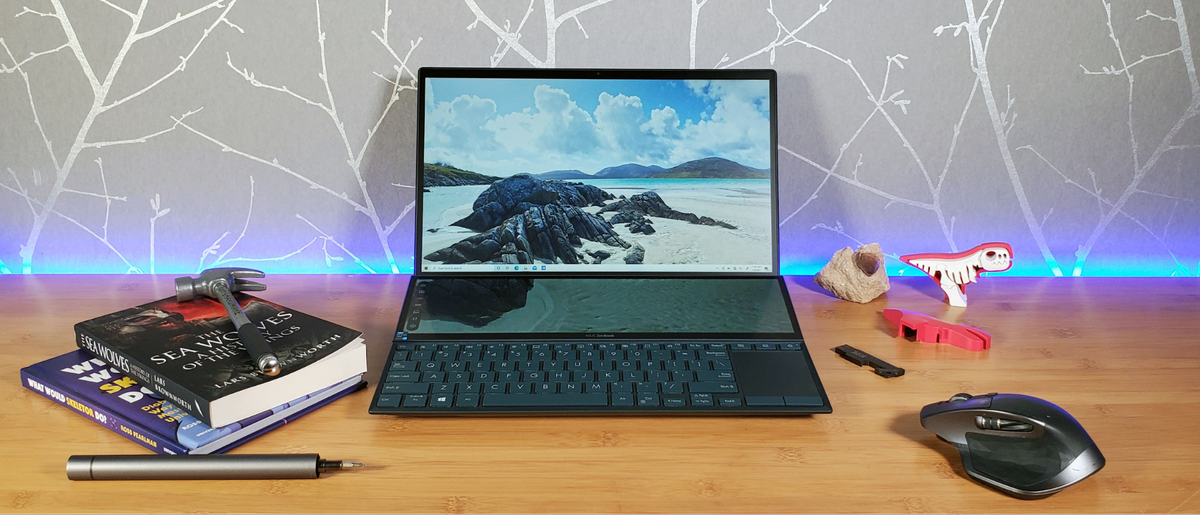Tom's Hardware Verdict
Asus' Zenbook Duo 14 UX482 improves the dual-screen laptop experience with better design, improved software and Intel 11th Gen muscle. But the typing and mousing experience is still compromised.
Pros
- +
$999 starting price with an i5
- +
Very good battery life
- +
Loud speakers
- +
Improved hinge mechanism and keyboard layout
Cons
- -
Keyboard/touchpad are still awkward
- -
8GB of RAM in lower-two configurations
Why you can trust Tom's Hardware
In some ways, Asus' ZenBook Duo 14 UX482 feels purpose-built for our times, which could put it on target to land on our best premium laptops list. Many of us continue to work or learn from home, attending to a seemingly endless list of tasks. Having extra screen real estate can help you be (or at least feel) more organized and on top of things, by letting you keep more windows and programs on screen at one time. The ZenBoook Duo 14 UX482 ($999 to start, $1,299 as tested) delivers two displays in a compact form factor (who doesn't feel cramped for space these days?), along with a Tiger Lake Intel 11th Gen i7 processor (and Nvidia MX450 in some models) and a design that's more refined than the previous-gen ZenBook Duo UX481.
The software that lets you easily launch, swap and organize programs from the 12.6-inch lower screen has also received a major 2.0 revision that both looks much better and makes it more versatile and substantive, particularly for content creators.
If you're after a laptop that delivers two screens for productivity in a sub-15-inch form factor, this is your best option. But despite some appreciated changes to the keyboard, including a larger right shift key, the cramped keys and small touchpad (which is still jammed up in the right corner of the deck) are still major concessions you'll have to make for this dual-screen design. So if you do a lot of writing, you may want to consider a traditional laptop, paired with a dedicated portable monitor.
Design and Features on the Asus ZenBook Duo 14 UX482
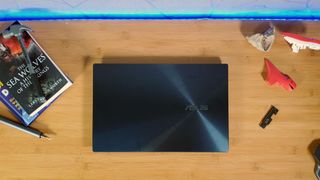
The ZenBook Duo 14 UX482 looks and feels familiar in some ways. It sports the same spun-metal lid design as many previous ZenBooks, the same "celestial blue" hue as the previous Duo UX841, and the same overall layout, with the keyboard moved down and the touchpad on the right.



The primary design change with this model is one carried over from the gaming-centric ROG Zephyrus Duo. Specifically, the lower second screen lifts up seven degrees at the back as you lift the lid, which manages the triple feat of improving cooling, giving you a better angle to view and work on the lower display, while also making the visible gap between the two screens smaller. The company has also again integrated its ErgoLift hinge here, which lifts the back of the laptop off the desk when you open the lid , again helping with cooling while giving the keys a pleasing slight angle for typing. But there's no lower lip to rest your wrists on, so for long typing sessions, you may want to bring a dedicated wrist rest, or at least a foam mouse pad or something similar.
The end result of the hinge and the tilt-up lower display (which is also brighter this time around at a rated 400 nits) is a more-refined two-screen presentation that makes using the two screens a more appealing, pleasing experience. It's a pity the same can't be said for the keyboard and touchpad. More on that later.


Thanks to the inclusion of an 11th Gen Intel processor (either an i7 or an i5, depending on the model), the left edge houses a pair of Thunderbolt 4 ports (either of which can be used for charging) and an HDMI port, while the right edge makes room for a single USB 3.2 Gen 1 Type-A port, an audio combo jack and a MicroSD slot.
At 3.53 pounds and 0.7 inches thick, the Zenbook Duo 14 UX482 is far from a featherweight. Single-screen competitors like the single-screen 2.8-pound MSI Prestige 14 Evo are lighter, but then you don't get the utility or wow factor of a second display. At least Asus has trimmed nearly half a pound off the weight of the previous ZenBook Duo, as well as making the new model about a tenth of an inch slimmer.
ScreenPad Plus
The first thing to be said about the 1920 x 515-resolution ScreenPad Plus touchscreen (which sits below the 1920 x 1080 main touch display), is that in person it looks much brighter than in many of these photos. In fact, Asus upped the peak brightness of the lower panel to a rating of 400 nits, matching that of the main display -- at least on paper. And when sitting right in front of the laptop with your face near the keys, the two panels look similarly bright (of course depending on how you adjust either one's brightness). Take a step or more back though, and the lower screen looks much dimmer, as viewing angle issues hide much of the backlight's output. But rest assured, in most situations where you're actively using the laptop, the lower screen looks good enough not to stand out starkly against the panel above it. That hasn't always been the case with previous dual-screen laptops from Asus.



As for the ScreenXpert Control Center software, which lets you actually do things with the lower display and swap windows back and forth with the upper screen, it's also received a major overhaul. It looks darker and more polished/professional in this 2.0 iteration. And it's also gotten much more customizable, letting you add, remove or rearrange the buttons on the dock, which can live on the left, right or bottom of the lower display, as well as auto-hide when not in use.
New functionality includes the ability to mirror your phone screen and even make calls when your phone is paired with the MyAsus app. You can also turn the entire ScreenPad into a touchpad, which can be handy for signatures or some light drawing (although active pens aren't supported). You can also set any app to launch directly to the ScreenPad Plus when launched via the ScreenXpert dock -- handy for music or chat apps that don't need lots of screen real estate.
The best features of the previous version of the software also carry over, like the ability to swap apps between screens with the tap of a button and save program layouts into groups so you can launch them and get your workspace back the way you like it with a couple of taps after rebooting.
For content creators, there's a new Control Panel app that turns the ScreenPad Plus into a customizable control deck, giving you sliders, wheels and buttons for commonly used tasks in AdobePhotoshop, Premiere, After Effects and lightroom.
For those who work in Adobe's programs for hours a day, this could be a primary selling point. Unfortunately, given the time constraints of this review, we didn't have time to test out this feature. We'll update this later if we find any issues or niceties worth noting.
All in all, it's clear that Asus has put a fair amount of effort into its ScreenXpert software. It feels more robust and mature than when we played with it last year. It only crashed on us once during testing of this model, and while it's not always super intuitive at first, those who like the idea of a dual-screen laptop enough to buy the ZenBook UX482 shouldn't have a hard time getting used to it. If you make use of most of its features, it can truly deliver an experience that's different and in some ways better than traditional single-screen laptops.
Asus ZenBook Duo 14 UX482 Specifications
| Display | 14 inch 1080p (1920 x1080) touchscreen, 12.6 inch (1920 x 515) ScreenPad Plus |
| CPU | Intel Core i7-1165G7 |
| Graphics | Intel Iris Xe |
| SSD | 512GB PCIe NVMe |
| Networking | Wi-Fi 6 (802.11ax) |
| Ports | 2x Thunderbolt 4 USB Type-C, 1x USB 3.2 Gen 1 Type-A, HDMI 1.4, MicroSD |
| Audio | 2x SonicMaster |
| Camera | 720p, IR (Windows Hello support) |
| Battery | 70Wh Li-Polymer |
| Power Adapter | 65W Type-C |
| Operating System | Windows 10 Home |
| Dimensions (WxDxH) | 12.8 x 8.7 x 0.7 inches / 32.4 x 22.2 x 1.7 cm |
| Weight | 3.53 pounds (1.6kg) |
| Price (as configured) | $1,299 as configured |
Productivity Performance on the Asus ZenBook Duo 14 UX482
We tested the $1,299 configuration of the Asus ZenBook Duo 14 UX482, with a quad-core Intel Core i7-1165G7 CPU, 8GB of RAM and a 512GB PCIe SSD. For comparison, we're pitting it against the single-screen MSI Prestige 14 Evo, which packs a similar Core i7-1185G7 processor (with a slightly higher top Turbo Frequency) and double the RAM (16GB). We also tossed in the latest Dell XPS 13 (9310, also with an i7-1165G7 and 16GB of RAM) and the previous-gen ZenBook Duo UX481, which had a previous-generation Core i7-10510U and 16GB of RAM.



Interestingly, in Geekbench 5, the new Duo UX482 lost out to the MSI Prestige Evo 14 on the single-core test, which is expected given that system's slightly higher top clock speed. But the Duo edged it out on the multi-core tests. Still, the smaller Dell XPS 13 edged ahead of everything here on the multi-core test.
The Duo UX482 took 14 minutes and 55 seconds to complete our Handbrake test, in which the laptop converts a 4K video to 1080p. That's easily faster than the Dell or previous-gen Asus, but the MSI was about 2:30 faster on the same task.
The Duo UX482 landed in last place in our file transfer test, copying our 4.97GB batch of mixed files at an average of just under 722 MBps. That's not necessarily a bad showing, just not every impressive, especially since the previous-generation Duo managed to top 1GBps on the same test.
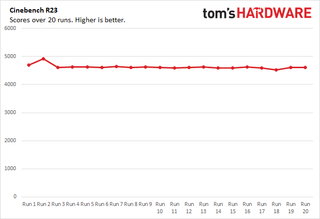
We stress-tested the Asus ZenBook Duo 14 UX482 by running Cinebench R23 on a loop 20 times. Aside from an initial bump up to 4,920 on the second run, performance was pretty consistent, ranging from 4,692 on the first run to a low of 4,516 on the penultimate run.
As for gaming, if you want to run any AAA titles on the Duo, you should opt for one of the higher-end models with Nvidia MX450 graphics. That chip is far from a powerhouse, but should serve you better than the Iris Xe graphics in our review rig. It's speedier than previous-generation Intel integrated GPUs, but when I tried to run Borderlands 3 on this system with Iris Xe, the game never got past the main screen. And it frequently crashed before it got there. Older and esports titles at lower settings are about the limit of what you should expect here -- especially if you don't opt for a model with Nvidia graphics.
Keyboard and Touchpad on the Asus ZenBook Duo 14 UX482
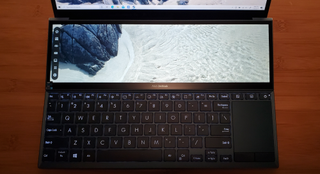
Asus has made strides to improve the keyboard of the ZenBook Duo 14 UX482 over its predecessor. And the larger right shift key is certainly appreciated, though it does come at the expense of half-size up/down arrow keys. The travel length of 1.4mm is appreciated, as are the gently scooped keys and the three-level white backlight.
But otherwise, the layout and experience here are more or less the same as the previous iteration. With this little vertical space (thanks to the second screen), combined with the lack of a keyboard deck/wrist rest and the fact that the tall, narrow touchpad is jammed to the right of the keys, the typing and mousing experience just isn't comfortable for lengthy sessions. At the very least, I feel like I'd want to carry a mouse and a thin wrist rest around with me when using the laptop for any serious writing. And that's arguably equally as inconvenient as toting around a portable monitor.
Displays on the Asus ZenBook Duo 14 UX482
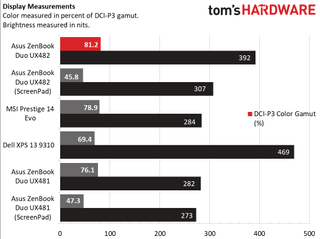
The primary display on the Duo UX482 is pretty good, delivering 81.2 percent of DCI-P3 gamut and a max brightness that's close to the 400 nit rating. That's better than any of the competition here for colors, and the brightness beats everything but the super-bright screen on the XPS 13.
But our testing shows the lower ScreenPad Plus isn't nearly as colorful and is also dimmer. It can't be easy for Asus to source a high-quality panel at this odd, super-wide aspect ratio and 1,920 x 515-resolution, but that doesn't mean we wouldn't love to see one that's a better match to the primary display.
Audio on the Asus ZenBook Duo 14 UX482
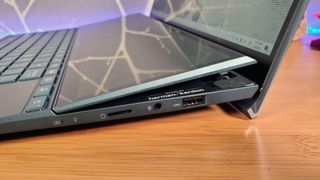
This iteration of the Zenbook Duo 14 sports a pair of speakers that can kick out some surprising sound. When I listened to the J-Rock goth-stomper “Muma - The Nightmare” by Buck-Tick, on my home office workbench, the song was almost too loud for comfort when standing in front of the laptop. Comfort was made worse by some noticeable distortion and highs that were a bit harsh to my ears.
Dialing the volume down to about 90 still left plenty of volume to fill the room and produced a clearer, more-enjoyable aural experience. Those looking for deep bass will want to connect external speakers or opt for a larger laptop with a small sub. But within the expectations of a compact laptop, the speakers here are surprisingly capable.
Battery Life on the Asus ZenBook Duo 14 UX482
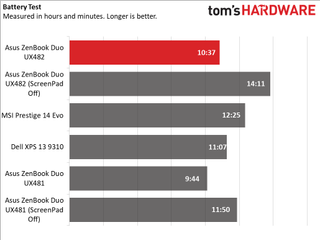
With both screens on, the new Duo 14 UX482 managed to add nearly an hour to its run time over the previous-generation Duo UX481 on our battery rundown test, which continuously browses the web, streams video and runs OpenGL tests. And while 10:37 is a good showing for a dual-screen laptop, if you switch the lower screen off (which you can do via a dedicated button to the left of the power button), run time jumps to over 14 hours, besting its closest competitor, the MSI Prestige 14 Evo by over 90 minutes.
So while Asus gives you the utility of a second display, it doesn't make you suffer for it in unplugged run time. If you remember to switch the ScreenPad off when you aren't using it, you should be able to get through a work day, plus a movie after hours before plugging in the laptop before bed.
Heat on the Asus ZenBook Duo 14 UX482
The ZenBook Duo 14 Duo UX482 isn't the coolest laptop in the world, but it doesn't get toasty like a super-slim gamer either -- at least not with the integrated graphics in our review configuration. After 15 minutes of streaming YouTube, the touchpad was 80 degrees Fahrenheit (26.7 degrees Celsius), while the spot between the G and H keys was one degree Fahrenheit warmer. On the bottom of the laptop, temps were in the 92 degree range (33.3 degrees C), save for near the serial/model number sticker, where we saw the highest temperature of 97 degrees Fahrenheit (36.1 degrees Celsius).
While the temperatures aren't exactly low here, they aren't toasty either. And perhaps most impressively, fan noise never got louder than a whispery whirr, even while I was running the Cinebench stress test for several minutes at a time.
Webcam on the Asus ZenBook Duo 14 UX482
The laptop's 720p webcam handles low light well, delivering a grainy but recognizable image of my face in my dark living room. But details remained soft even under bright lighting, and colors like bright yellows and red seemed unnaturally bright, making books on a shelf behind me jump out, without delivering enough fine detail to tell what they actually are.
The camera here will serve well enough for video chats -- and may let you leave the lights low for that Monday morning Zoom meeting. But don't expect stand-out detail or color accuracy. You can at least use it to log in via Windows Hello. On that front, the camera performed flawlessly.
Configuration and Upgradability on the Asus ZenBook Duo 14 UX482
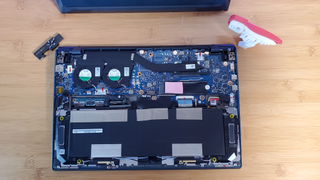
Getting inside the Zenbook Duo 14 UX482 is fairly easy, provided you have a tiny Torx bit and are willing to mar the rubber that Asus uses to cover 5 of the 9 total screws. After all are removed, the bottom pops off easily, granting access to a large 70Whr battery and a small, unorthodox motherboard (and daughterboard) plus a CPU cooled by a single chunky heatpipe. There's a lot going on here, but in terms of upgradability, there's just the single occupied M.2 slot. Asus says the RAM is soldered onto the board.
As far as configurations go, Asus will offer up four models of the UX482. Starting at a surprisingly affordable (for a dual-screen laptop) $999, the UX482EA-ES51T gets you a Core i5-1135G7 CPU, 8GB of RAM and a 512GB PCIe SSD. Next up the stack is our $1,299 review configuration (UX482EA-DS71T), which steps up to the i7-1165G7 while keeping other specs the same.
Arguably the best option in terms of value and performance is the $1,499 UX482EG-XS74T, which doubles the RAM and storage (16GB/1TB) while also offering up modest Nvidia MX450 graphics. That should make more games playable (although still often at low settings), but may also negatively affect battery life (though we haven't tested that model so can't say for sure). Lastly, there's the $1,699 UX482EG-XS77T, which maxes the RAM out at 32GB. All models feature 1080p displays and the same 1920 x 515 ScreenPad Plus panel.
Software and Warranty
Aside from the ScreenXpert 2.0 software, the laptop comes with the usual Windows bloat, like Spotify and links to Hulu and Roblox. Also pre-installed is the MyAsus system support and diagnostic suite. Here you can also do things like enable AI noise cancelling for the mics and cycle through various presets for the display. I just wish Asus could avoid adding an AppDeals section. Some of the links here purport to give you 15-20% off Adobe apps and 50% off Polaris Office. Some may find these offers worthwhile, but it's hard not to see this as a cash grab baked into an already expensive laptop.
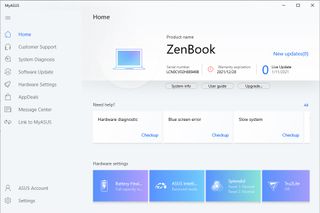
Asus ships the ZenBook Duo 14 UX482 with a limited one-year warranty.
Bottom Line
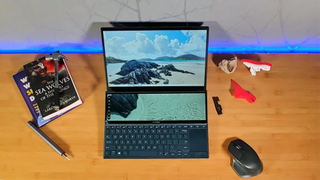
As both a full-time writer/editor and a huge fan of screen real estate and multiple monitors (I currently have three 4K displays, including a 55-inch TV that I use as my main productivity panel), I feel very conflicted about the ZenBook Duo 14 UX482. I don't think there's any doubt that it's the best implementation of a compact dual-screen laptop available. That was also true of the previous model, and Asus has made some substantive changes to both the hardware and software, while a newer CPU brings better performance and longer battery life.
It's also clear that Asus is committed to the dual-screen design. The company is actively recruiting developers to add express support for its dual-screen software, going so far as to ask reviewers to include a link to an Asus email for developers looking to jump on the Duo bandwagon (ASC_support@asus.com). While dual-screen laptops are still pretty niche, Asus does make three models currently: the Pro Duo aimed at creators, the ROG Zephyrus Duo 15, and the 14-inch model we're looking at here. So both from a consumer and developer standpoint, Asus' Duo models should stand out.
But as someone who spends more time working with text than videos or images, I can't fully get behind the compromised keyboard and touchpad, despite the work Asus has done to improve things. The only reasonable solution I can think of (aside from wildly complex engineering) would be for Asus to move to a taller 3:2 screen in future models, rather than 16:9. That's something laptop makers have been experimenting with in productivity machines recently, and could give enough extra room on the keyboard deck for a more comfortable keyboard and touchscreen layout.
But of course not all (or even most) users spend as much time as I do typing and editing via the keyboard. For visual content creators, multi-screen multitasking obsessives and anyone looking for more screens in a small space, the ZenBook Duo 14 UX482 is well worth considering. We'd lean, though, towards opting for either the $999 entry model or the $1,499 version with twice the RAM and storage, plus Nvidia graphics. Because $1,299 is a lot to pay for a laptop with 8GB of RAM -- especially one with a second display designed to help you keep more programs running in the foreground at once. And because the RAM is soldered, you can't add more on your own.
After a rough start with the Mattel Aquarius as a child, Matt built his first PC in the late 1990s and ventured into mild PC modding in the early 2000s. He’s spent the last 15 years covering emerging technology for Smithsonian, Popular Science, and Consumer Reports, while testing components and PCs for Computer Shopper, PCMag and Digital Trends.

Zotac's Safety Light feature averts 16-pin power connector meltdowns on RTX 50 GPUs — the mechanism prevents GPU power-on until the cable is fully inserted

This 3D-printed Raspberry Pi all-in-one is made for portable gaming

BiWin Black Opal X570 Pro 4TB PCIe 5.0 — SSD using SM2508 controller, coming in March 2025
-
PapaCrazy The keyboard and trackpad are huge compromises on this laptop, and get in the way of its workstation goals. I would love to see Asus make the trackpad larger and removable. It could be stored in a slide-out compartment and connect via BT when removed. This would allow for a full sized keyboard and an ergonomic position. When opening the laptop for a quick e-mail check or something, a virtual trackpad could be placed on the lower screen since it is touch-enabled. Once the physical trackpad is undocked, the virtual trackpad would disappear.Reply
